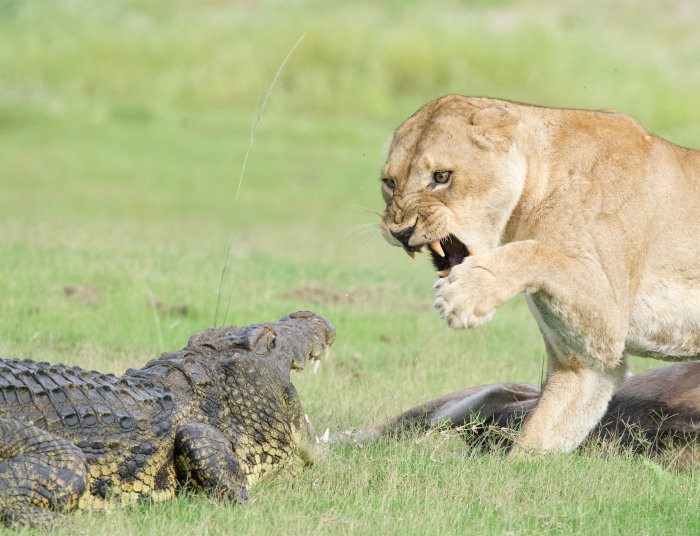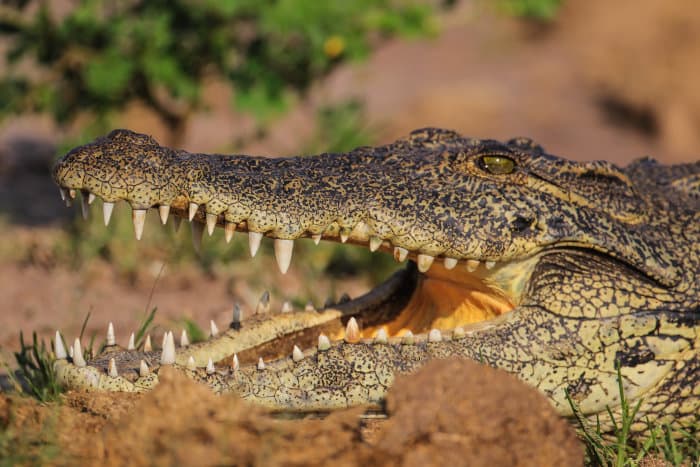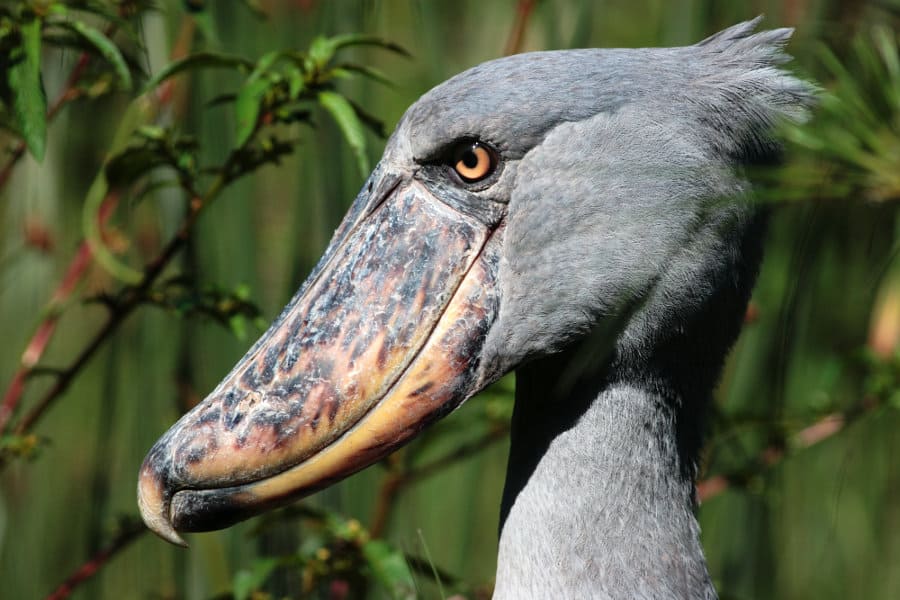What sounds do crocodiles make? It might not be a question you’ve considered, yet these chatty crocodilians have a fascinating range of vocalisations.
There are many unique crocodile sounds, each used in different contexts. It could be male crocs fighting over females, staking their territory, or baby crocodiles communicating with their mothers.
As new studies emerge, crocs continue to surprise scientists with their methods of communication. Yet there’s still much left to learn about these enigmatic creatures.
What’s the difference between a crocodile growl and a crocodile roar? Can they hiss like a snake? And how do crocodiles make these sounds?
Read on to learn all about the different crocodile noises and their meanings.
A Surprising Array of Crocodile Sounds

Some think of crocodiles as mindless predators, only concerned with their next meal. Yet below the surface (often literally), crocodiles live complex social lives and communicate in a variety of ways.
Sure, they can be silent when hunting, but when they’re not waiting patiently to ambush prey, crocodiles and alligators are the most vocal of all reptiles.
One Australian researcher discovered 13 different crocodile sounds, from coughs and growls to roars and hisses. Crocodiles ‘talk’ to each other in other non-verbal ways, too, like slapping the water, and even blowing bubbles.
Understanding all these noises can be difficult, and there’s still a lot more to learn about what croc sounds really mean. Yet there’s already a lot of fascinating information about crocodile communication.
Here are some of the most common crocodile noises and their meanings.
The Fearsome Crocodile Roar (or Bellow)
As you’d expect from an apex predator, croc sounds can be scary. When a male wants to intimidate his rivals, or win over a female, he unleashes the impressive crocodile roar – also known as a bellow.
Males will raise their head and tail out of the water, visibly inflating. Then they’ll puff out their throat and vibrate air through their closed mouth.
Crocodiles bellow throughout the year, but it’s most common in the breeding season, when groups of crocs congregate. The powerful, low-frequency vibrations can travel great distances, and even make the water appear to ‘dance’.
One study on alligators found that bellows communicate body size. Larger alligators have longer vocal cords and therefore lower-pitched bellows, so other individuals can steer clear if they’re outmatched.
Other species, like Nile crocodiles, also have a size-based hierarchy. Bellowing is a good way to demonstrate dominance without having to fight – although it doesn’t always prevent violence.
Male Nile crocodiles will also slap the water with their snouts and spray water from their noses to mark their territory and ward off rivals.
Growl
A crocodile growl is a lot like a bellow – a low-pitched, guttural noise often used for mating or territorial displays. Both males and females will growl, and it’s still not fully known what it means in every context.
Hiss

Can crocodiles hiss? Yes.
Snakes aren’t the only reptiles that hiss – several crocodilians can do so, including alligators, caiman, and some crocodile species.
A crocodile hiss is basically a warning, telling you to back off! Should you find yourself on the receiving end, you should take the advice and move off to a safe distance.
Cough
Don’t be too surprised if you hear a croc coughing. It’s not often seen (maybe because they’re too polite to do it in public), but crocodiles cough up ‘furballs’ just like cats.
Crocs can’t digest fur or chitin (the substance in arthropod exoskeletons), so mammal and shellfish meals form a ball in their stomach. The crocodile will have to regurgitate them up, which sounds a lot like a cough.
Baby Crocodile Sounds: Grunts and Squeaks

Crocodiles start making noises early on in life – before they’ve even hatched, in fact. Baby crocodile sounds are essential for communicating with their mother and making it out of the nest.
Female crocodiles lay eggs in holes in the sand or in mounds of vegetation. After a few months of incubation, the young begin to hatch, and they start calling from inside the egg.
The hatchlings aren’t strong enough to excavate themselves, so their mother comes to their aid. With her sharp hearing, she responds to the calls and helps dig them out of the nest.
Baby crocodile sounds could be best described as a high-pitched squeak – certainly not as intimidating as an adult’s vocalisations. If you hear a baby croc squeaking in the wild, you’d best not stick around, as their mother will soon be there to check up on them.
Baby Nile crocodiles stay with their mother for up to two years. As well as squeaks, they also communicate with grunting sounds.
Predatory response
Crocs even react to other species’ babies – in a very different way, though.
One recent study found that Nile crocodiles were quick to investigate crying human, chimpanzee, and bonobo babies. (Luckily, they used audio recordings rather than the real thing!)
When the recordings were played, many of the crocs quickly swam towards the sound. Some approached underwater in an obviously predatory fashion, and a few even tried to bite the speakers.
It makes sense – predators love an easy meal, and a young, helpless animal makes a great snack in the wild.
Not all responses were predatory, though. The study’s authors thought that some female crocodiles may have responded with protective behaviour, with the ape cries tapping into their innate motherly instincts.
Intriguing, but probably still not a great idea to use a croc as a babysitter.
How Do Crocodiles Make Sounds?

Crocodilians, just like humans, have a larynx, and make sounds by vibrating their vocal cords. Yet the exact mechanism for crocodile noises has, until recently, been a bit of a mystery.
One study investigated alligator sound production by looking at the larynx anatomy. The authors found that alligators could employ complex motor control to make an array of sounds.
One particular muscle, the cricoarytenoid, plays an important role in vocal cord length and tension.
Crocodilians can produce some sounds at such low frequencies that the human ear can’t pick up on them, known as infrasound. Yet we can see its effects on the croc’s surroundings, like when the water vibrates during a crocodile bellow.
Crocodile Hearing
As well as making sounds, crocodiles must also be able to react to them. Whether hunting, hatching, or reproducing, crocodile hearing plays a big role in the reptiles’ everyday lives.
Crocodiles have very good hearing and are highly sensitive to different pitches, allowing them to respond differently to a wounded animal’s cries, a baby’s distress call, or a rival’s territorial display.
Crocodile communication is largely based on frequency, and different families of crocodilians can still ‘understand’ each other as they share an ‘acoustic code’.
In one study, juvenile Nile crocodiles were played recorded calls from two species of caiman, a relative in the alligator family. Since the calls had a similar frequency to those of Nile crocodiles, the young crocs still responded to them.
Do crocodiles have ears?

Yes, crocodiles have ears. You might struggle to spot them at first, since there’s no external ear. A croc’s ear just looks like a small slit, located behind its eyes.
Crocodiles often submerge themselves with their ears slightly out of the water, but when they dive down, special flaps close over the ears to prevent water getting in.
Unlike humans, crocodile hearing doesn’t decline with age, as they create new hair cells in the ears throughout their lives.
Other senses
Crocodiles don’t just rely on hearing; they need their other senses to be sharp.
Crocodile eyes may not have the best depth perception or see in the highest detail, but they do boast excellent night vision and a panoramic, almost 360-degree field of view.
Crocodiles also have three eyelids. The middle eyelid is a clear membrane that essentially acts like a pair of goggles, allowing the animal to see underwater without damaging its eyes.
A superb sense of smell comes in handy when sniffing out live prey or carcasses to scavenge.
Finally, nerve-filled sense organs on their snouts also aid these reptiles’ rapid reactions to disturbances in the water.
Captivating Crocodile Sounds

Now you know the answer to the question: ‘what sounds do crocodiles make?’, and what many of these crocodile noises mean.
There’s still a lot more to learn about crocodile communication, but it’s clear that they’re much more complex creatures than most people think.
If you want to hear some crocodile sounds for yourself, why not head out on safari to see these impressive animals in the wild?
There are five crocodile species in Africa, but the largest and most widespread is the Nile crocodile, which lives in 26 African countries.
Whether basking on the shore of one of Africa’s most famous rivers, or poking its head out of the water in a rural lake, there are plenty of places to spot this amazing predator.



